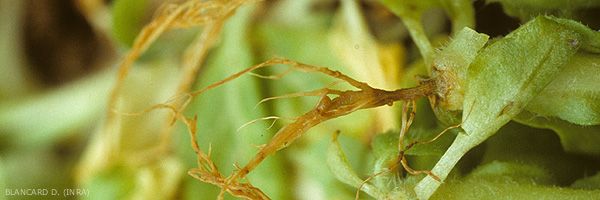
Olpidium brassicae
(Woronin) P.A. Dang. (1886)
- English names : Olpidium seedling blight, root burn disease
There is no doubt that Olpidium brassicae is globally widespread. Presently it is not considered as a serious pathogen of tobacco, because it mainly affects plants in nurseries and its outbreaks are relatively rare. The development of the floating seedbed methods may change this situation, at least in some countries of temperate climate. In France, where this technique is rather popular, the fungus can be observed in the roots of seedlings with (figure 1 and 2) or without root symptoms (see the fact sheet on Damping-off).
This fungus also vectors several viruses to tobacco (TNV = tobacco necrosis virus and TStV = tobacco stunt virus) and to other plants such as lettuce (LBVV = lettuce big-vein virus) and Cucurbitaceae (TNV). Currently, crucifer-infecting species are called Olpidium brassicae, while lettuce-infecting species are now called Olpidium virulentus. Olpidium bornovanus has been reported on melons and some ornamental plants. The tobacco pathogen is still regarded as O. brassicae.
 |
 |
 |
| Figure 1 | Figure 2 | Figure 3 |
Other Chytridiales (figures 1 to 3), sometimes accompany the "root loss" observed in floating seedbeds. They are observed alone or with Olpidium brassicae on and in the root tissues. Their identification is not easy. The structures observed in tobacco cells or near them are somewhat like those that indicate the presence of Rhizophydium spp. or other aquatic fungi. Some of them have already been observed in the roots of several Nicotiana species, especially on tobacco: Lagena radicicola Vanterpool & Lindergham and Rhizophydium graminis Ledingham.
The pathogenicity of these fungi on tobacco is not clearly defined. Are they parasites of weak plants? Do they occur as saprophytes, here considered as biological indicators of a certain state of the root system?





